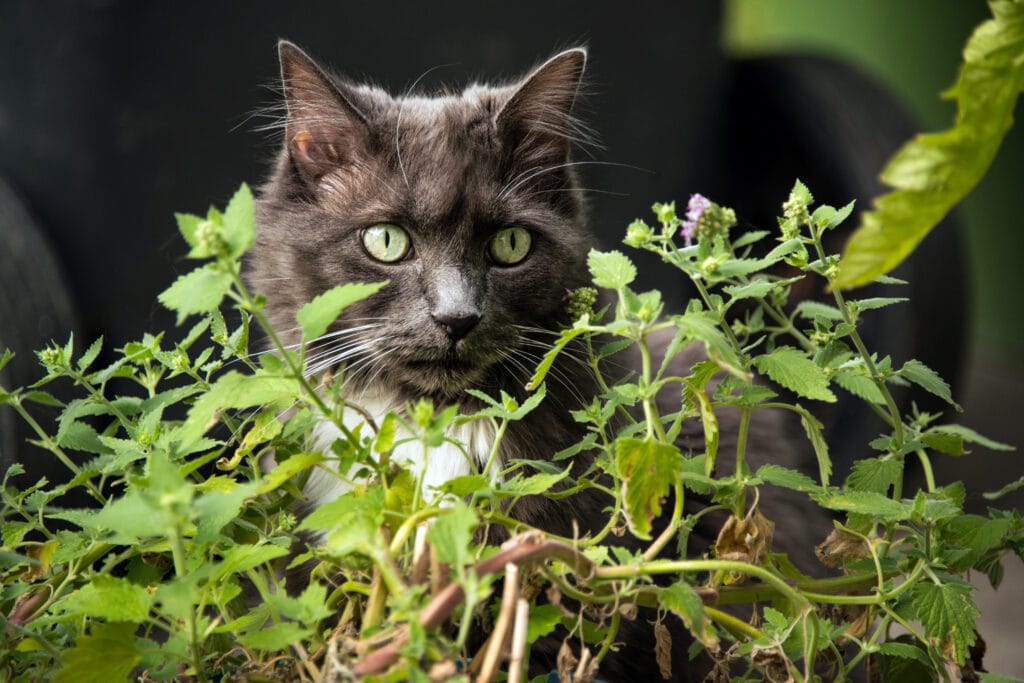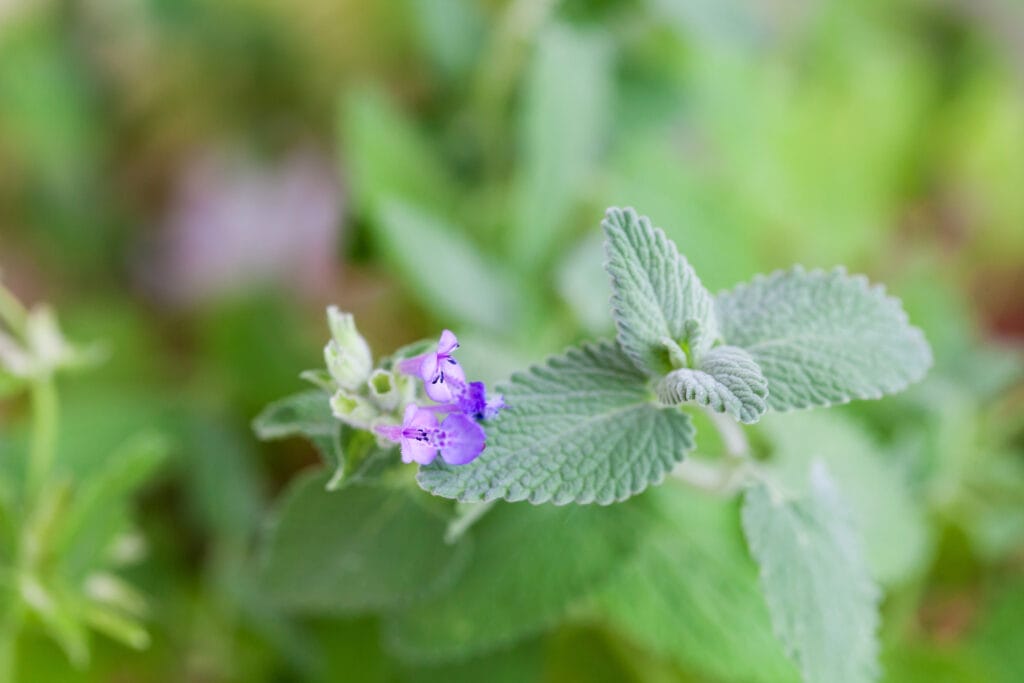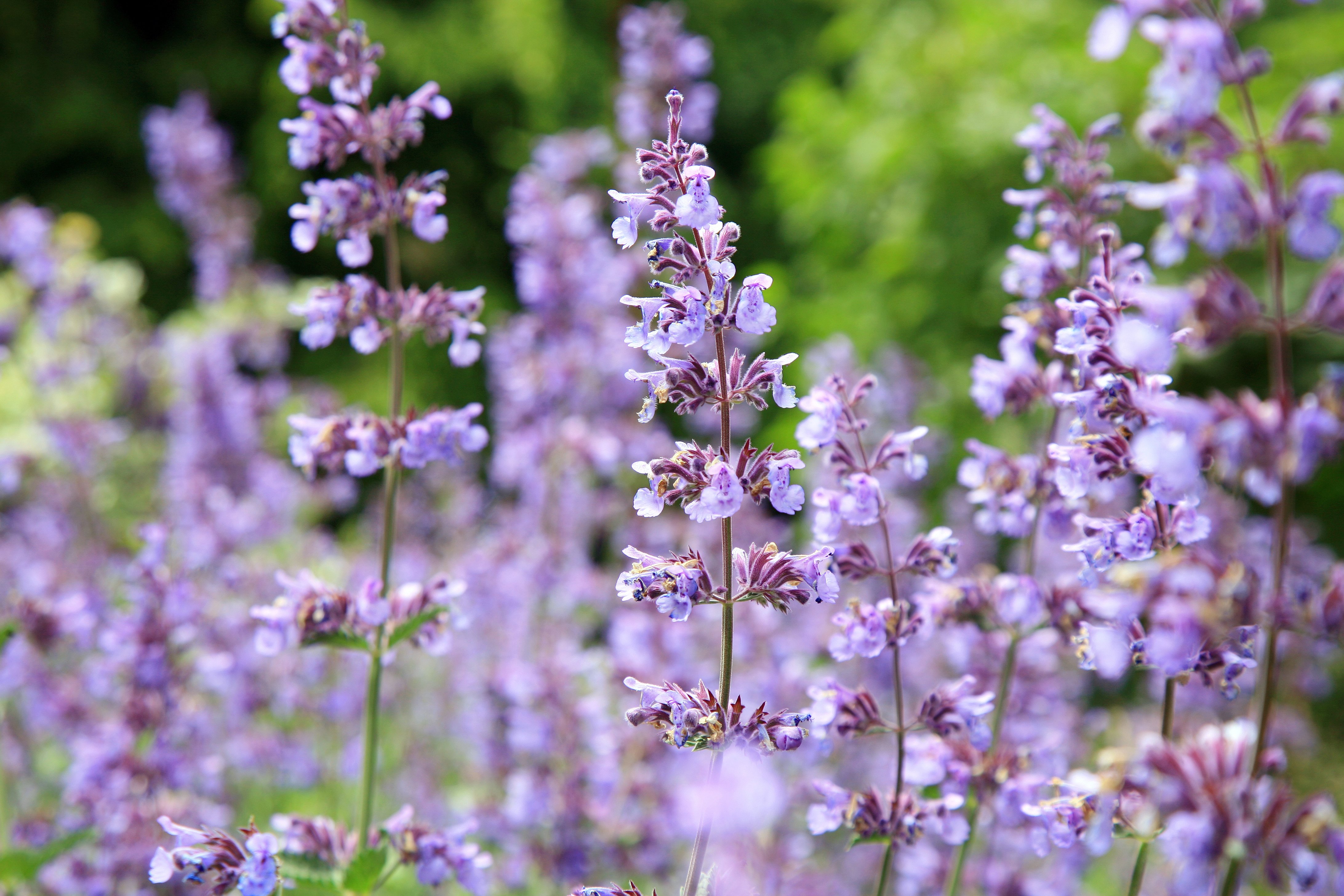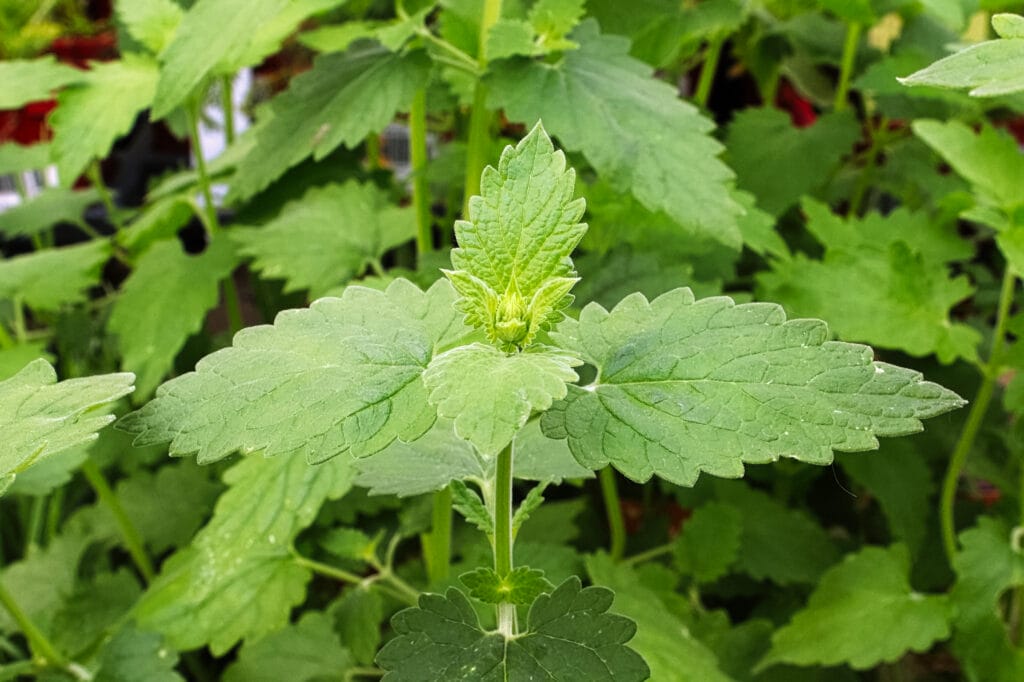Have you ever been interested in learning How to Grow Catnip?
Do you have a cat that would benefit from homegrown catnip?
Or would you like to use catnip for your own herbal and medicinal purposes?

Because these are common questions, I have created 10 EASY Tips on How to Grow Catnip so that you can enjoy this tasteful herb all year, no matter where you live.
[toc]
Choose THIS Type of Catnip (Tips #1)
Are you interested in catnip for your cat? How about for its herbal and medicinal remedies for you?
There are more ways to use catnip than you can count.
But in order to have the most success with the uses of catnip, you have to identify the correct type to grow.
While there are 5 types of catnip you can grow, only 1 is true catnip.
This is the easiest type of catnip to grow from seed or plant. It also has the most uses, is easiest to care for, and is quickest to harvest.
1. Common Catnip

Common Catnip (Nepeta Cataria) is also known as catnip, catswort, or catmint.
This type of catnip grows in hardy zones 3 to 9 and is a native plant of Europe, but can grow almost anywhere in the world.
This variety of catnip is most favored by cats and the stem and leaves are covered in fine, downy hairs. The leaves are heart-shaped and of gray-green color.
When in bloom, catnip has beautiful white flowers and can grow up to 3 feet tall. Bloom time can be expected in summer and fall.
Purchase the BEST Garden Supplies (Tips #2-5)
2. Purchase the Right Seed
When learning how to grow catnip from seed the seed itself is the most important supply.
While vegetables typically have numerous types of seeds like organic, heirloom, GMO, etc. catnip plants typically grow from your traditional seed or organic.
Whether you purchase organic seeds or traditional seeds you will have the same results. There is no benefit to your health and your harvest will be no different.
What is important is where you purchase your catnip seeds from.
If you want seeds that come from reputable companies at a reasonable price and with quick delivery then you want to purchase them from Amazon.
3. Buy 2 Types of Containers
Once you purchase your seeds you will need at least 1 type of pot to start your catnip and two types of pots if you want to garden all year.
I typically don’t recommend planting your seeds directly into the soil because disease, pests, and mother nature will damage or destroy too many of them.
Instead, I recommend starting off your seed in 3-inch pots. My suggestion is GrowKo Peat Pots.
Next, you’ll want a much larger pot if you do not plan on transplanting your catnip into a garden.
The reason for this is that 3 inch pots are great for seeds and starting small plants, but cannot sustain the root growth needed for catnip leaf growth.
I recommend Viagrow 5 Gallon Nursery Pot
4. Buy These Garden Tools!
While containers and seeds are the only two essential tools you need when learning how to grow catnip from seed there are other garden tools that will make your life easy.
Of the most basic, but handiest garden supplies to have is a good sprayer.
You want to use a good sprayer because hoses and cups will flood your seed rendering it useless.
I recommend Tolco Spray Bottle 8 oz.
In addition, it is also great to have good garden utensils to help minimize dirt and disorganization.
If you want one of the best gardening tool sets then I recommend Vremi 9 piece tool set.
And finally, you can’t grow catnip seeds inside without a good grow light. If you have access to a warm sunny area for at least 8 hours a day you won’t need a grow light.
Most of us don’t have access to that much sunlight during the winter. And sometimes even if we do a grow light is just more effective for the best results.
I specifically recommend Hydrofarm Grow Light.
5. Buy Soil & Fertilizer
Just because you have the best seeds and a pot to start your catnip doesn’t mean you’ll have success.
You want to make sure you have the correct soil and good fertilizer.
If you do not have the proper soil your seed will not fully grow and bare leaves. And while you can survive without fertilizer, a good mixture will help you get the most out of your catnip plant.
While there are lots of soil you can buy, we will want to focus on the only one you need, potting mix.
Very simply, this soil will contain the right mixture of soil, sand, and nutrients needed for your Catnip seeds to grow healthy.
I am highly recommending: Miracle-Gro Potting Mix.
I am recommending this type of soil for a couple of reasons.
Everything you need to start seeds and provide your catnip with the correct nutrients can be found in this soil.
And if you decide you want to transplant your catnip plant to another pot you will not need to purchase a different type of soil.
In addition, you want to make sure you have a good fertilizer to help your catnip grow as large and fruitful as possible.
I use and recommend Miracle-Gro Plant Food.
Why I like this type of fertilizer is that it provides everything your catnip plant needs. And you won’t have to worry about the type of mixture to use or how to use it.
Best of all is that this type of fertilizer can be used on all your vegetable and herb plants!
How to Start Seeds Indoors (Tip #6)

When learning how to grow catnip from seed you should almost always start your process indoors.
Step 1
You will want to start your catnip seeds inside approximately 8-12 weeks before you plan on moving your catnip into your garden or moving your larger container.
You want to first start by filling your 3 inches pot 80% full with your potting mix.
Next, you will want to spray the soil immediately after 5-10 times. You want the soil to be damp, but not soaked. You will know the soil is damp when it turns a dark brown color.
Step 2
Next, use the tip of a pencil and make a circular motion to form a tiny hole. This will be approximately 1/8 inch deep.
Then place 2 to 3 seeds into the hole and brush the soil over the seeds.
You will then spray the soil again 5 to 8 times. Moisten, but do not dampen the soil.
Step 3
After planting your seeds place your pots in direct sunlight or under your grow light. Your seeds will need approximately 8 hours of sunlight.
If you put your seeds under the grow light keep it approximately 4 inches from the bulb. Anything closer will burn the seeds. Anything further away with not provides enough heat and light.
You will also need to make sure the room temperature is around 70 degrees Fahrenheit.
If the air temperature does not stay around this temperature then your seeds will not germinate or pop through the soil.
If you don’t have an area that will stay consistently around 70 degrees, I would recommend investing in a Plant Heating Mat.
A Plant Heating Mat is the perfect way to keep your pots and seeds at a consistent temperature that we may not otherwise be able to. The best part about a heat mat is you just plug it in and you are all set.
Step 4
After your initial planting, you will need to spray the soil once to twice a day.
You will know it’s time to spray if the soil looks a light brown color or feels dry to the touch.
It will take approximately 10 days for your seeds to germinate or pop through the soil. Do not worry if it takes a few days later as each growing situation is different.
Step 5
Continue spraying your catnip (as referred to step 4) over the next 4-8 weeks.
Once your catnip reaches 3 inches tall you will either want to move them into your larger containers or move them outside.
If you move your catnip plants into a larger container you can continue to water them twice a day until they are ready to be harvested.
You should only move your catnip plants outside if the temperature is above freezing.
While catnip plants are cold hardy plants, consistent frost will kill them.
You can view your hardy zone below to determine your first and last frost date of the year.
When transplanting your catnip plant into a garden you will want to dig a hole that is the size of your catnip plant root ball (where the roots meet the soil). Next, cover it with soil and water it for 30 seconds.
It should also be noted that you will not need to thin your catnip plant like you would with vegetables or herbs.
Typically, 2-3 catnip plants can grow in one pot without any problems. This will also give you the fullest harvest.
If you learn better watching a video then I recommend watching the below youtube tutorial:
How to Care for Catnip (Tip #7)

Below are tips for caring for your Catnip throughout the summer:
- Water catnip at least once a week after it is had been in the ground or container for a couple of weeks
- Harvest regularly. This will promote catnip growth faster and at greater quantity.
- Before the last frost of the year prune your catnip down to the ground. All you need to do is take a pair of pruning shears or scissors and cut the prune about 2-3 inches above the ground.
There is no need to fence your catnip. Squirrel, Rabbits, and Deer hate the taste of mint.
Also, you do not need to fertilize your catnip. Mint is an invasive plant that will grow rapidly in almost any climate.
And finally, you do not need to apply a pesticide. Catnip is incredibly hardy against insects and disease.
How to Harvest Catnip (Tip #8)
In order to harvest catnip, all you need to do is grab where the leaf meets the stem and pull off the catnip leaf.
You will want to harvest every couple of weeks to promote growth and quantity.
How to Store Catnip (Tip #9)
While catnip is a hardy plant, it does not hold up well at room temperature once harvested.
You should expect your catnip leaves to stay fresh for approximately 48-72 hours.
After this time period, you will notice the catnip leaves begin to wilt. This does not mean it is bad, it just won’t hold its flavor as well.
If you want to store your catnip for a period of up to a week you can simply place them in a zip-lock bag and place them in your fridge.
If you want your catnip to last for approximately two-three weeks then I recommend wrapping your catnip in a dampened paper towel.
Then place this towel in a zip-lock bag. Do not zip the bag. Air circulation is key to preventing mold and keeping your catnip fresh.
And finally, if you want catnip to last even longer then you can either dry or freeze catnip. This will allow you to use it all year long!
BEST Catnip Use Ideas (Tip #10)
So planting, caring, and harvesting catnip plants is fun, but using catnip is the best part!
Below, are a few of the uses of catnip that are both easy and most enjoyable:
- Creating essential oil: Catnip oil can be used to reduce stress, is great for your skin, and can help repel mosquitoes.
- Related: Natural Mosquito Repellent Plants
- Cat “Drug”: Catnip is a great “drug” for cats. It helps keep them active, can be inserted in toys, and can be used in many other DIY items.
- Catnip Tea: You can create your own tea recipe to help with insomnia, anxiety, and headaches.
Conclusion
After reading this article you should now have a much better idea on How to Grow Catnip from seeds and how to have the greatest chance for success.
If you want to have the most success, I recommend these 10 SIMPLE Tips:
- Use the recommended type of Catnip for the best chance of success
- Buy the Correct Seeds. Organic or traditional doesn’t matter as much as where you purchase them from
- Buy two different types of containers to help allow your catnip to grow to its fullest potential
- Garden tools aren’t essential, but they will make gardening easier!
- The correct soil and fertilizer can turn your catnip from good to great
- There are only 5 simple steps for starting your seed in a pot and this should take less than 15 minutes
- Proper care for your catnip will allow you to get the most harvest
- Harvesting catnip leaves is an art and science. Never over-harvest
- Catnip leaves can be stored in cool, dark places, the fridge, or even the freezer
- There are many great uses for catnip leaves. Don’t be afraid to try different recipes
If you enjoyed this article then please read my other articles: